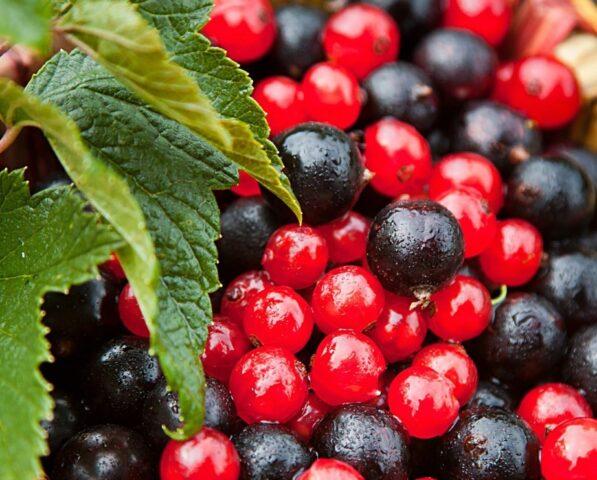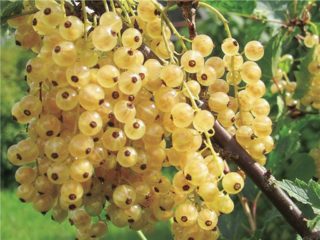Content
- 1 Is it possible to feed currants with starch?
- 2 What are the benefits of starch for currants?
- 3 Timing for feeding currants with potato starch
- 4 How to dilute potato starch for watering currants
- 5 Top dressing from potato peelings
- 6 How to feed currants with potato starch
- 7 Conclusion
- 8 Reviews on the use of starch for feeding currants
Feeding currants with starch in the spring is an effective way to increase crop yields and make the berries sweeter. In order for fertilizer to bring maximum benefit to plants, you need to know how to prepare it correctly and use it in the feeding process.

Starch is an inexpensive and effective means for feeding berry bushes
Is it possible to feed currants with starch?
Currants love starch - this is a fact that has long been proven and confirmed by the results of numerous observations. Due to the content of a large number of useful substances, including vitamin C, potassium and glucose, using the element as a fertilizer for bushes helps strengthen the plant's immunity and get a good harvest of large, sweet berries. That is why gardeners recommend feeding currants with potato starch in the spring.

The beneficial properties of starch are due to its chemical composition
What are the benefits of starch for currants?
Potato starch contains sufficient quantities for plants of vitamins A, B and C, amino acids, glucose and minerals - potassium, calcium, sulfur, magnesium, iron and a number of other useful compounds. All this makes the potato processing product an ideal raw material for feeding garden plants, including currants.
Using starch as a fertilizer for red and black species:
- activates the growth of green mass;
- helps increase crop yield;
- helps increase the size of berries and increases their sugar content;
- prevents the appearance of barren flowers and premature falling of flower petals;
- prevents wilting on the bush and shedding of berries;
- increases currant resistance to fungal diseases;
- helps survive drought and temperature changes;
- improves the structure of the soil and saturates it with useful substances;
- increases the breathability of the soil, which, in turn, provides oxygen access to the roots and reduces the likelihood of developing fungal diseases.
The presence of potassium helps to increase the strength of the shoots, which helps plants to easily withstand strong gusts of wind in both warm and cold seasons.
The list of advantages of starch also includes the fact that it is an accessible and inexpensive means for feeding berry bushes, which can be done not only by an experienced gardener, but also by a beginner.

The product can be purchased at any grocery store
Timing for feeding currants with potato starch
Gardeners recommend fertilizing currants with starch, the recipe for making fertilizer from which is not particularly difficult, three times a year:
- in the spring at the beginning of the budding period for active growth of shoots and increase in vegetative mass;
- at the stage of fruit formation to increase the number of ovaries;
- in the fall in the process of preparing the plant for the cold season to strengthen the immune system and ensure a comfortable wintering.
How to dilute potato starch for watering currants
You can buy potato starch for feeding currant bushes ready-made in the store or prepare it yourself from potato peelings.
If using a purchased substance, fertilizer is made as follows:
- cook jelly at the rate of 250 g of starch per 3 liters of water;
- the finished product is diluted with water to obtain a total volume of 10 l;
- the resulting concentrate is once again diluted with water in a ratio of 2 liters of brewed starch per 10 liters of water.
The fertilizer is ready for use. It is recommended to pour 5-10 liters of solution under each bush.

Starch is diluted with water and brought to a boil
Top dressing from potato peelings
The ideal raw material for fertilizer can be ordinary potato peelings, which are always left over as a result of preparing dishes from this root vegetable.
To make a nutritional composition out of them, you need:
- Pour hot water over the peels so that it completely covers them, and leave for 5-6 hours until completely softened. Ideally, cover the bucket with a lid, so the water will cool longer and the cleaning will be softer.
- When the peel is properly softened, crush it or beat it with a mixer until you obtain a homogeneous porridge-like substance.
The resulting product can be incorporated into the soil in this form or diluted with water in a ratio of 1x5 and watered with the solution on the bushes.
Considering that a fairly large amount of potato peel is needed for feeding, it can be stored for a long time - dried or frozen.
There are other ways to prepare nutritional formula. For example, some gardeners grind the tubers together with the peel in a meat grinder, then dilute the resulting pulp with water and pour it under each bush.

Regular potato peelings will help improve the taste of currants.
How to feed currants with potato starch
Feeding currant bushes with starch is not particularly difficult. To do this, you will need a pre-prepared nutrient mixture, water for irrigation and a shovel.
black currant
The method of feeding black currants with starch depends on the form of the nutrient mixture used.
When using an aqueous solution, first clean the soil in the root zone of plants from weeds, after which they spill it generously with plain water (at least two buckets for each bush). When the water is completely absorbed into the soil, 5-10 liters (depending on the age of the bush) of a previously prepared aqueous solution, that is, jelly diluted with water, are poured under each plant.
When using mushy fertilizer, the soil, as in the previous method, is cleared of weeds and grooves 10-15 cm deep are made around the bushes. After this, the prepared fertilizer is laid out in the grooves and covered with soil. At the end of the procedure, the soil is watered abundantly with ordinary water at room temperature.
For fertilizing to be effective, at least 1 kg of mushy product should be placed under each bush.
Simply scattering fresh peelings over the surface of the soil in the area of currant bushes will not bring any benefit. In order for the plant to absorb useful substances from such fertilizer, they need to be buried at least 5 cm into the soil, and burying fresh peels is not very convenient. Moreover, uncovered peelings can attract the attention of rodents, which is definitely not good for the currants.
red currant
Treatment of red currant starch in the spring is carried out according to the same principle as feeding black currants.
Experienced gardeners recommend combining several types of fertilizer to fertilize crops whose berries are more acidic than dark ones. That is, first water the plants with an aqueous solution of starch, and after a few days add a slurry of peelings into the soil in the root zone.

Any type of fertilizing with starch will benefit currants
Conclusion
Feeding currants with starch is a good way to save on expensive fertilizers and get a harvest of large sugar berries. Preparing such a mixture is quite simple and quick, so anyone can cope with the task.
Reviews on the use of starch for feeding currants








